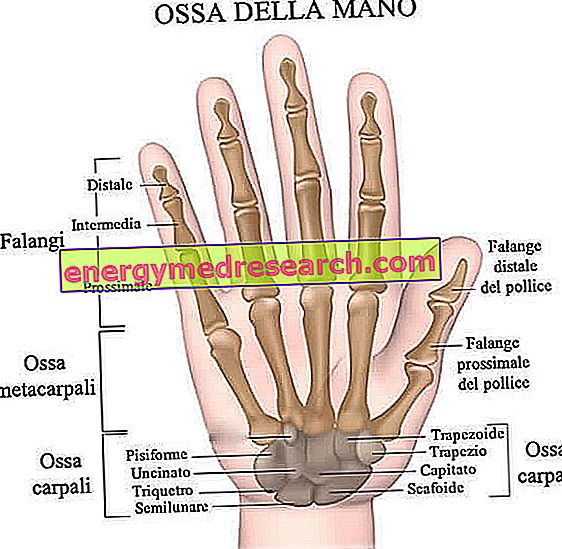Generality
In human beings, the bones of the hand are the skeletal structure of the terminal part of each upper limb. There are a total of 27 and, according to the anatomists, they can be divided into three large groups: the bones of the carpus (or carpal bones or carpus), the metacarpal bones (or metacarpals) and the bones of the fingers of the hand (or phalanges of the hand).
The carpal bones represent the proximal portion of the skeleton of the hand; the metacarpals represent the intermediate portion of the skeleton of the hand; finally, the phalanges of the hand represent the distal portion of the skeleton of the hand.
The bones of the hand contribute to the ability to grip the hand, guarantee stability to the child during walking on all fours, constitute very important joints (eg: the wrist joint) and, finally, give insertion to the tendons of the hand muscles.
Like any bone in the human skeleton, the bones of the hand can also fracture.

What are the bones of the hand?
In the human being, the bones of the hand are what constitutes the skeleton of the terminal part of each upper limb.
Inside the human body, the hands are two anatomical structures that serve to:
- Grab the objects;
- Perceive through the sense of touch;
- To communicate;
- Guarantee stability during the first years of life, when human beings still walk on all fours.
Anatomy
In all 27, the bones of the hand can be divided into three large groups: the bones of the carpus (or more simply carpus ), the metacarpal bones (or metacarpals ) and the bones of the fingers of the hand (or phalanges of the hand ).
The bones of the carpus are 8 and represent the proximal skeletal portion of the hand; the metacarpal bones are 5 and represent the intermediate skeletal portion of the hand; finally, the phalanges of the hand are 14 and represent the distal skeletal portion of the hand.
In anatomy, proximal and distal are two terms with the opposite meaning.
Proximal means "closer to the center of the body" or "closer to the point of origin". Referring to the femur, for example, it indicates the portion of this bone closest to the trunk.
Distal, on the other hand, means "farther from the center of the body" or "farther from the point of origin". Referred (always to the femur), for example, it indicates the portion of this bone furthest from the trunk (and closer to the knee joint).
BONE OF THE CARPO
Irregularly shaped, the 8 bones of the carpus form the anatomical region of the wrist, disposing in two rows: a proximal row, close to the bones of the radius and ulna arm, and a distal row, bordering the base of the metacarpal bones.
The bones of the proximal row are: scaphoid, semilunar, triquatum and pisiform .
The bones of the distal row, on the other hand, are: trapezoid, trapezoid, capitate and hooked .
- Proximal carpal bones . The bones of the proximal row play a fundamental role in the constitution of the wrist joint (which should not be confused with the aforementioned anatomical region).
While scaphoid and semilunar articulate with the two articular surfaces of the radius, the triqueter and pisiform form insert into an important ligament that comes from the styloid process of the ulna.
- Distal carpal bones . The carpal bones of the distal row have the important task of articulating the carpus to the pasterns.
While trapezoid, trapezoid and capitate articulate with the base of a metacarpal bone only, the unbleached joins two adjacent metacarpal bones.
To be precise, the trapezoid borders on the metacarpus preceding the thumb; the trapezoid makes contact with the metacarpus preceding the index; the capitate is at the base of the metacarpus that precedes the middle; finally, the unconditioned articulates with the metacarpals that precede annular and little finger.
METACARPALI BONES
The metacarpal bones, or metacarpals, are long bones, arranged parallel to each other, in which it is possible to distinguish three regions: a central region, called body ; a proximal region, called the base ; finally, a distal region, identified with the term head .
The base of the metacarpus borders with the bones of the carpus according to the scheme described in the previous subchapter: therefore, starting from the side of the thumb, the base of the metacarpus preceding the thumb adheres to the trapezium; the base of the metacarpus that proceeds the index adheres to the trapezoid; the base of the metacarpus preceding the ring finger adheres to the capitate; finally, the bases of the metacarpals that precede the annular and the little finger adhere to the uncured one.
The head of the metacarpus is the region that makes contact with the first phalanx of the fingers: it results that each metacarpus corresponds to a finger of the hand.
Between the base of the metacarpals and the bones of the carpus there are a series of joints, as well as between the head of the metacarpals and the first phalanges of the hand.
HAND FALANGES
Cylindrical in shape, the phalanges of the hand are the skeleton of the 5 fingers of the hand.
Except the thumb - the only one formed by 2 phalanges - all the other fingers of the hand have 3 phalanges each.
The phalanges closest to the head of the pasterns are called the first phalanges (or proximal phalanges ); starting from these, the following are called second phalanges (or intermediate phalanges ) and third phalanges (or distal phalanges ).
Between each phalanx there is an articulation, which gives the fingers of the hand a certain mobility.
In the case of arthrosis (or osteoarthritis ), the joints between the second and third phalanges of the fingers are the articular elements that develop the so-called Heberden nodules .
Note : in the first finger of the hand, the numbering of the phalanges ends with the second phalanges.
Functions
The bones of the hand and their particular arrangement play a decisive role in some functions of the hand, such as in the grip of objects or in the four-legged walk of the child.
In addition, the bones of the hand form very important joints (eg the wrist joint), insert into the ligaments that constitute a fundamental part of the aforementioned joints and are the point of attachment of the tendons belonging to the so-called hand muscles .
diseases
Like all bones in the body, the bones of the hand can also fracture.
There are three classes of fractures to the bones of the hand: fractures of the carpal bones, fractures of the metacarpals (or metacarpal fractures) and fractures of the phalanges.
FRACTURE OF A BONE OF CARPO
The bones of the hand in the carpus, which most commonly undergo a fracture, are the scaphoid, the lunate and the trapezius.
Among the main causes of scaphoid fracture are falls with hands extended forward; among the typical causes of fractures of the lunate, there are direct blows to the wrist and chronic traumas; finally, among the classic causes of trapezium fracture, there are violent blows to the back of the hand and falls with a closed fist and radial deviation (ie bent towards the radium).
The characteristic symptom of fractures of the carpal bones is pain.
For a correct diagnosis, an X-ray examination is essential.
The treatment of compound fractures of the carpal bones involves the application of a plaster on the patient's hand. The cast can last from a minimum of 4 to a maximum of 12 weeks.
Unlike the previous case, the treatment of displaced fractures of the carpus bones involves surgery. In such circumstances, the purpose of the surgical procedure is to fix the various bone segments between them, by means of screws and pins.
Proper treatment is essential to avoid long-term complications (eg, arthritis of the wrist).
FRACTURE OF A METACARPO
The bones of the hand with the metacarpal seat, which fracture more easily, are the first metacarpal - precisely the base of the first metacarpal - and the fifth metacarpal - to be precise, the region that just slightly precedes the head.
In medicine, the fracture of the base of the first metacarpal is called Bennett 's fracture, while the fracture of the region preceding the head of the fifth metacarpal is called the boxer's fracture .
Generally, Bennett's fracture is subsequent to a thumb hyperabduction. The break of the boxer, on the other hand, is a consequence of punches against objects with a certain resistance; it is called a boxer's fracture, because it is typical of boxers.
To diagnose fractures of a metacarpus, an X-ray examination is essential.
The treatment of a metacarpal fracture depends on the severity of the injury.
In fact, if the fracture is stable and not particularly severe, doctors opt for the application, on the patient's hand, of a pinstriped splint, to be held in position for about 2-3 weeks. If the fracture is stable and severe, the cast of the affected hand is expected for at least 4-6 weeks. Finally, if the fracture is unstable, the therapy chosen by the doctors is surgical and consists of an operation aimed at the union, by means of screws, of the separated bony portions.
FRACTURE OF A HAND FALANGE
Fractures of one or more phalanges of the hand are conditions of slight gravity, which arise as a result of traumatic events that damage the fingers of the hand (eg: crushing of a finger). Generally, the treatment of fractures of the bones of the fingers constituting simply consists of a period of rest.



